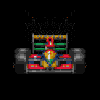hollus wrote:But Raikonnen wasn't "there". Think of what part of his car he lost as proof, impossible if he was "already there" in the outside.
Cars don't have instantaneous stopping power.
This is to some degree similar to what caused the incident in Barcelona too. Car B behind closing in on Car A. Car B has two choices; go to the inside or attempt a move around the outside. This decision is for the most part dictated by Car A. Does he choose to cover the inside or the outside? If Car A blocks the inside, then Car B can attempt to go around the outside, at the expense of taking the longer way around and having the "door close on corner exit". If Car A goes to the outside, Car B will go to the inside, go in deep and then shut the door on corner exit.
From those two scenarios, the chances on a successful pass is statistically a lot higher if Car A allows Car B to go for the inside, which is why Car A will always,
always try to cover the inside. Doing so is not without a draw back however - if you cover the inside, you are compromising your corner exit speed as you are shortening the radius of the corner significantly. Because of this, Car A, covering the inside will always
want to move back to the racing line to be able to carry more speed into the corner and not compromise his exit too much.
Usually when Car B passes Car A on the inside, it's because Car A failed to cover the inside. This happens more often than one would think, because Car A might not always be looking in his rear-mirrors to see if the car behind is attempting an overtake. It's completely at the discretion of Car A. "
Is he close enough to attempt a pass? Do I need to defend, cover the inside and compromise my corner entry (and lose time) or am I safe to stay on the racing line because my attacker is too far off to attempt a pass?".
The problem with where this incident took place was because it was between two corners. Verstappen came out, closer to the inside of the upcoming left-hander. Kimi had momentum, coming in fast. There was space on the ouside. Then Verstappen made a decisive move, jerked the wheel to the right and completely blocked the outside (this was Verstappen moving onto the racing line). Kimi jumped at this move and probably shouted "thank you" for leaving the door open on the inside. He dived into that gap, but then Verstappen closed that gap too by aiming for the apex which then prompted Kimi having to take avoiding action by turning to the right and hitting Verstappen in the process.
What's important to note is that cars don't have instantaneous stopping power. There is a point at which a driver commits to a move. Past that point, there's no way you will successfully stop your car without hitting the car in front. This was the case with Kimi - he was carrying a lot more speed and when you are this close, it's important that cars/drivers make decisive moves - either cover the inside or the outside, but not change direction mid corner to "get back onto the racing line". This is what ultimately caused the collision.


